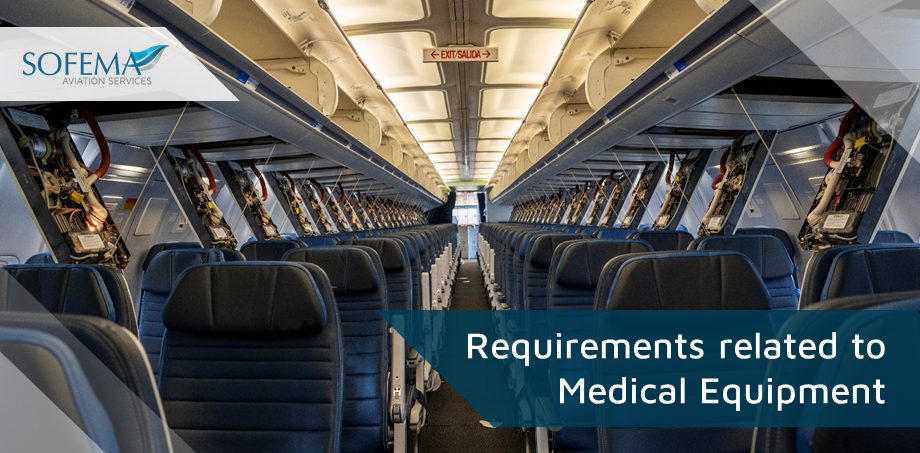Sofema Aviation Services (SAS) www.sassofia.com considers EASA requirements related to stretchers and additional medical equipment
Introduction
The design of the stretcher must comply with the following paragraphs CS 25:
- CS 25.561 Emergency Landing Conditions
- CS 25.625 Fitting factors
- CS 25.785 Seats, berths, safety belts and harnesses
- CS 25.787 Stowage compartments
- CS 25.789 Retention of items of mass in passenger and crew compartments and galleys
- CS 25.791 Passenger information signs
- CS 25.807 Passenger Emergency Exits
- CS 25.812 Emergency Lighting
- CS 25.813 Emergency exit access
- CS 25.815 Width of aisle
- CS 25.853 Compartment interiors
- CS 25.1501 General
- CS 25.1529 Instructions for Continued Airworthiness
- CS 25.1541 Markings and placards
Having considered the benefit of evacuating injured or critically sick people from areas where, for many different reasons, their health and/or safety is at high risk, EASA is of the opinion that non-compliance with the following
- CS25.803,
- CS25.785(j),
- CS25.785(h)(2),
- CS25.1411(f),
- CS25.1415(e) and
- CS25.1447(c)(1),
Can be sufficiently compensated by showing compliance with the following Special Conditions :
- a) In regards to seated occupants, each crew and passenger area must have emergency means to allow rapid evacuation in crash landings, with the landing gear extended as well as with the landing gear retracted, considering the possibility of the aeroplane being on fire.
o In regards to stretcher occupants, all practicable design precautions and operational procedures must be developed to facilitate evacuation without compromising the egress of cabin attendants and other passengers.
o Precautions may include features such as location relative to normal passenger seating and emergency exits,
o Easy release of stretchers from their attachments to the a/c to enable patients to be stretcher-borne to emergency exits,
o Easily accessed patient restraint buckles to alternatively allow removal and direct carrying of patients, associated training/briefing procedures for attendants, etc.
Proposed design precautions and procedures will be evaluated by the Agency for acceptability.
An entry shall be made in an AFM supplement to define the procedure to be followed for the evacuation of the occupants of the stretchers.
Notes: The stretcher shall provide an adequate restraining means for the person, using such devices as a shoulder harness, the appropriate number of body belts and/or end board, taking into consideration the aircraft flight loads and the loads under requirements of CS 25.561 and keeping all loads on the occupant’s body to a minimum.
Besides the protection of the occupant, all constructive features have to take into account the protection of other passengers, e.g. appropriate padding of exposed protuberances, etc.
EASA interpretation of 25.853 requirements for the stretcher mattress has been reviewed to be consistent with past decisions related to the flammability of individual cabin items.
- Considering its cushion function, the stretcher mattress must also comply with 25.853(b), and therefore successfully pass the flammability testing of Part II of Appendix F on CS 25.
Oxygen Equipment
All equipment intended to be certified as part of the installation (medical equipment, oxygen bottles, etc.) must be approved against the appropriate qualification standard.
Article 10 of Regulation (EC) No 1107/2006 establishes the rights of disabled persons and persons with reduced mobility when travelling by air. The Regulation also stipulates that air operators should provide assistance, including transportation of medical equipment subject to dangerous goods legislation.
Article 4(3) of this Regulation requires an air carrier or its agent to make publicly available the safety requirements and relevant information on restrictions.
Note: Where the national authorities allow oxygen bottles of less than 5 kg to be taken on board, it is still left to the discretion of the operator to accept them, also due to safety reasons (oxygen is highly flammable and it cannot be guaranteed that the bottles/valves have been maintained properly).
Next Steps
Follow this link to our Library to find & Download related documents for Free.
Sofema Aviation Services (SAS) Provides Classroom & Webinar Training, including the following course: EASA CS 25 Compliant Cabin Certification & Mods Training Program – 5 Days
Please see our websites www.sassofia.com and www.sofemaonline.com or email team@sassofia.com
Tags:
Aeroplane, Oxygen Equipment, Special Conditions, Passenger Emergency Exits, Emergency Lighting, Emergency Landing, Oxygen Bottles, Medical Equipment, Sofema Aviation Services (SAS), Aircraft, CS 25, SAS blogs, Continued Airworthiness, Airworthiness, EASA, Compliance, aviation





